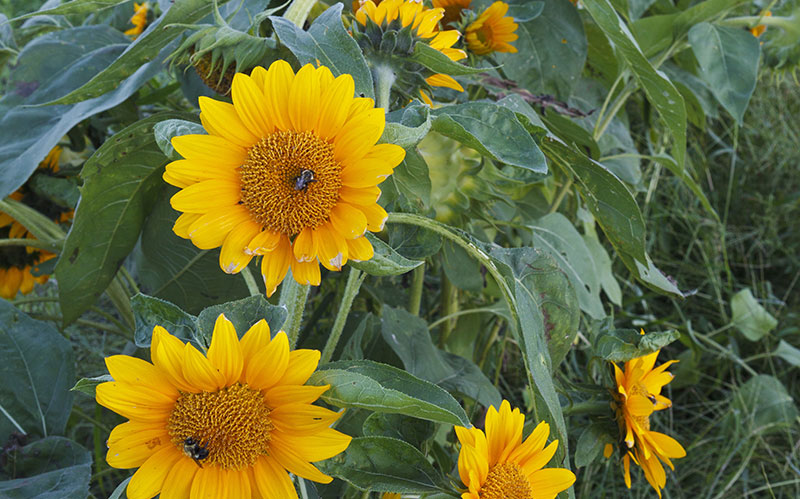
Neonicotinoids are a class of insecticide that not only kill off pollinators but are tied to neurological harms in humans. Photo: Courtesy EcoPhotography.
By now, you’ve heard the buzz. The bee population is on the decline, and it’s scary. That’s because bees and other pollinators, like butterflies, beetles, and hoverflies, do the job of pollinating our food crops. In the U.S., honey bees alone pollinate $15 billion in agricultural products each year, including more than 130 types of fruits, nuts, and vegetables. Without their services, we could no longer enjoy peppers, pumpkins, apples, blueberries, apricots, avocados, almonds, or chocolate. And that is indeed a bitter pill to swallow.
Pollinator populations of all types have plummeted in recent decades. Since 2007, some bee populations in forests have fallen by 80% and butterflies by 60%, according to the USDA. Globally, some species of bees are on the verge of disappearing altogether.
Our overheating planet is one reason we’re witnessing this collapse. Warmer temperatures cause habitat loss, new diseases, and new parasites that threaten the health of pollinators. Another big reason for the die-off: pesticides. Neonicotinoids, a class of insecticide used widely on farms and urban landscapes, are especially problematic. “Neonics,” as they are often called, are dangerous to pollinators, our food crops, our bodies, and the environment.
Here are five things you should know about this dangerous pesticide as we celebrate bees, butterflies, and more this National Pollinators Month.
1. Scientists are finding neonicotinoids everywhere.
When we say everywhere, we mean it. Neonics have shown up in the urine of pregnant women, white-tailed deer, farmland with no history of neonicotinoid use, water, and pollen collected by honeybees. They’ve spread far and wide because these pesticides are applied as colorful insecticidal coatings on seeds sold to farmers. Once applied to seeds, they are absorbed by plants, appearing in their leaves, flowers, and pollen. That pollen and nectar become toxic to bees.
But, of course, plants infused with neonics are also eaten by animals and humans. That means humans and animals are gorging on pesticides, too –an unappetizing thought. Also, most of the insecticide meant for plants soaks into the soil and leaches into both surface water and groundwater. So, we’re all potentially drinking this nasty stuff. What’s worse, some studies have found links between chronic exposure to neonicotinoids and neurological harm in humans. Neonicotinoid-treated corn and soybean seeds dominate New England, leaving the region’s residents, animals, crops, water, and overall ecosystem at risk for all the disease and devastation these pesticides can cause.
2. Just four agribusinesses dominate the global seed industry.
It may be hard to believe, but a handful of companies are doing all this damage. They are Corteva, BASF, ChemChina, and Bayer, which owns Monsanto. Large and powerful, these companies patent and push profitable genetically modified seeds and manufacture the pesticides that coat them.
3. Neonicotinoid-treated seeds are touted as cheap insurance against pests, but farmers see little benefit.
For all the damage they cause, one might hope there’d be some benefit to using neonics other than fattening the wallets of powerful corporations. Turns out, there isn’t. According to the EPA, one analysis shows no overall benefits when neonics were used on soybeans. An authoritative 2020 Cornell review of more than 200 other studies found no overall net income benefit of neonic seed treatments for farmers of corn and soy. But even if there were, would the significant effects of these pesticides on soil health, now documented in studies, be worth it?
4. Agribusiness is peddling misinformation.
Unsurprisingly, agribusiness is desperately looking for ways to counter studies revealing how damaging these pesticides are. So they’ve gotten busy peddling misinformation and discrediting experts. That tactic may sound familiar. It’s what the tobacco companies did for decades before smoking was widely recognized as carcinogenic. It’s also what oil companies have done since the 1960s in denying that the use of fossil fuels is overheating the planet. Big Ag has gotten so good at spin that, according to the European Academies Science Advisory Council, their “extensive lobbying, marketing, and manipulation” keeps many farmers using pesticides that, long term, could make their job raising crops far harder.
5. Jurisdictions are fighting back.
If the toll of neonics on our pollinators and food system sounds discouraging, there is some good news. Some countries and states are not letting Big Ag get away with killing off our ecosystem one dollar at a time. The European Commission has banned the outdoor use of major neonicotinoids after finding that their use risks killing bees. Québec requires farmers who want to use neonicotinoid-treated seeds to get a prescription from an agronomist before they do. Ontario requires farmers to complete integrated pest management training, emphasizing using pesticides as a last resort. New York law will soon require farmers to undergo the same kind of training, develop a pest risk report, and obtain a waiver from state environmental regulators before planting neonicotinoid-treated seeds. And in Vermont, legislators overwhelmingly passed the Pollinator Protection Bill to prohibit the use of most neonicotinoid-treated seeds. Governor Phil Scott vetoed that bill, and legislators will decide whether to override his veto later this month.
If we hope to protect our food, water, soil, and animals – not to mention human health – we must stop using neonicotinoids right now. If our pollinators disappear, farmers lose their livelihood, and we all lose many of the foods we love.
This is one in an occasional series revealing the truth behind environmental issues.



